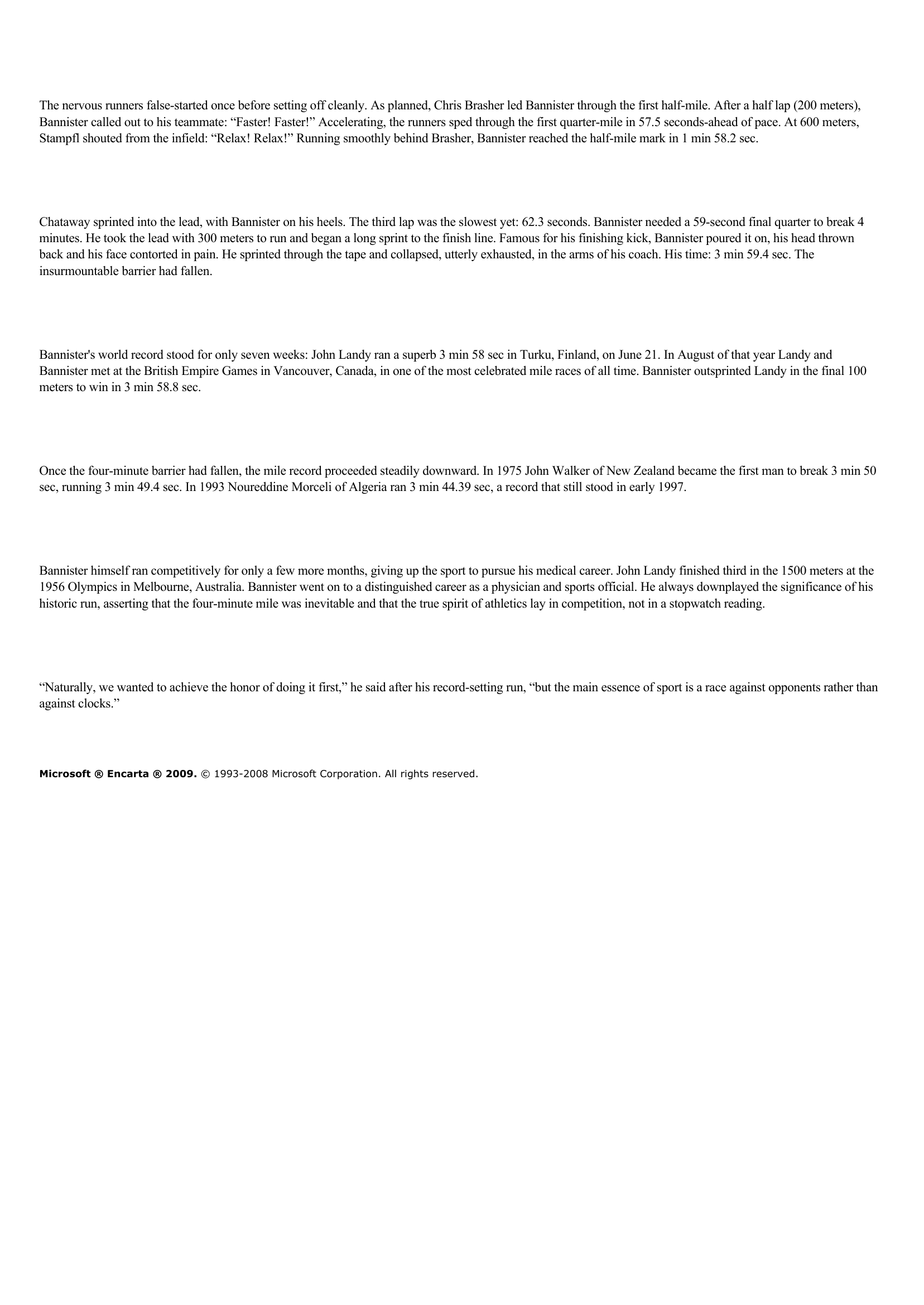The Four-Minute Mile.
Publié le 14/05/2013

Extrait du document
«
The nervous runners false-started once before setting off cleanly.
As planned, Chris Brasher led Bannister through the first half-mile.
After a half lap (200 meters),Bannister called out to his teammate: “Faster! Faster!” Accelerating, the runners sped through the first quarter-mile in 57.5 seconds-ahead of pace.
At 600 meters,Stampfl shouted from the infield: “Relax! Relax!” Running smoothly behind Brasher, Bannister reached the half-mile mark in 1 min 58.2 sec.
Chataway sprinted into the lead, with Bannister on his heels.
The third lap was the slowest yet: 62.3 seconds.
Bannister needed a 59-second final quarter to break 4minutes.
He took the lead with 300 meters to run and began a long sprint to the finish line.
Famous for his finishing kick, Bannister poured it on, his head thrownback and his face contorted in pain.
He sprinted through the tape and collapsed, utterly exhausted, in the arms of his coach.
His time: 3 min 59.4 sec.
Theinsurmountable barrier had fallen.
Bannister's world record stood for only seven weeks: John Landy ran a superb 3 min 58 sec in Turku, Finland, on June 21.
In August of that year Landy andBannister met at the British Empire Games in Vancouver, Canada, in one of the most celebrated mile races of all time.
Bannister outsprinted Landy in the final 100meters to win in 3 min 58.8 sec.
Once the four-minute barrier had fallen, the mile record proceeded steadily downward.
In 1975 John Walker of New Zealand became the first man to break 3 min 50sec, running 3 min 49.4 sec.
In 1993 Noureddine Morceli of Algeria ran 3 min 44.39 sec, a record that still stood in early 1997.
Bannister himself ran competitively for only a few more months, giving up the sport to pursue his medical career.
John Landy finished third in the 1500 meters at the1956 Olympics in Melbourne, Australia.
Bannister went on to a distinguished career as a physician and sports official.
He always downplayed the significance of hishistoric run, asserting that the four-minute mile was inevitable and that the true spirit of athletics lay in competition, not in a stopwatch reading.
“Naturally, we wanted to achieve the honor of doing it first,” he said after his record-setting run, “but the main essence of sport is a race against opponents rather thanagainst clocks.”
Microsoft ® Encarta ® 2009. © 1993-2008 Microsoft Corporation.
All rights reserved..
»
↓↓↓ APERÇU DU DOCUMENT ↓↓↓
Liens utiles
- ALCIPHRON [Alciphron or the Minute Philosopher]. (résumé & analyse) Georges Berkeley
- FOOTBALL a match two teams playing against each other in a 90-minute game of football a pitch the area where footballers play a match a referee the person who makes sure that the players follow the rules.
- At the beginning of the film, there are a back-to-school day of the the academic school of Welton: It’s a ceremony which remind the principles of the school like the four pillars: Tradition, Honor, Discipline, Excellence.
- Olympic Games Greek The principal athletic meeting of the ancient Greeks held every four years.
- Carl Lewis Carl Lewis, born in 1961, American track-and-field athlete, who won a total of nine gold medals at the Olympic Games in 1984, 1988, 1992, and 1996, including four straight gold medal performances in the long jump.


